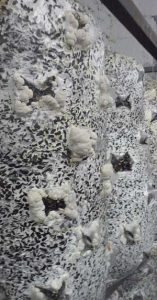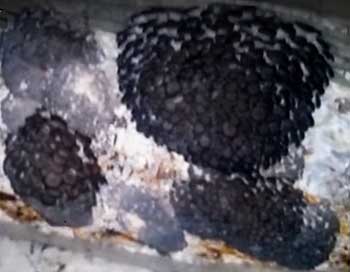
Read about how oyster mushroom primordia look and form here.
Table of Contents:
 When the mycelium is completely overgrown in the substrate, we begin to gradually lower the temperature and the amount of carbon dioxide in the growing room.
When the mycelium is completely overgrown in the substrate, we begin to gradually lower the temperature and the amount of carbon dioxide in the growing room.
Changes in climate conditions cause (initiate) the appearance of primordia.
After the massive formation of hyphal knots, we also turn on the light.
Do oyster mushrooms need cold shock?
About 15-20 years ago, the trigger for many oyster mushroom strains was temperature shock (cold shock).
Nowadays such varieties are practically not used.
If you have a chart in which the temperature and humidity are plotted by day, look carefully at how quickly you need to lower the temperature after the hyphal knots appear.
I've had clients claim that their strain needs a temperature shock and show me daily temperature charts. It always turned out that the temperature from +21-22 degrees Celsius needs to be lowered to +16-17 degrees not quickly, that is, “shock”, but slowly - 1 degree every 6-8 hours.
A sharp drop to 13-14 degrees with a subsequent rise in temperature to the cultivation level is also not recommended now.
Since condensation due to a sharp increase in humidity, which occurs with a sharp drop in temperature, can kill the mycelium and hyphal nodes in the slots.
In this article I will tell you how to stimulate the growth of primordia so that they appear simultaneously.
This method of changing climatic conditions can be used in those growing rooms where all mushroom blocks are of the same age.
During incubation, it is necessary to monitor the temperature in the center of the block and the subfilm layer.
The incubation of the mushroom blocks is complete when these temperatures stop dropping and remain stable. As a rule, they are higher than indoors: the center of the substrate is by 3-4 °C, and the temperature of the subfilm layer is by 1-1.5 degrees.
At the end of the whitening stage (10-12 days from the start of incubation), it is necessary to begin gradually, within 3-4 days, lower the amount of carbon dioxide to 1300 ppm.
At this time, the mycelium compacts around the slits, forming hyphal knots. It becomes like a halo; this process is an indicator that it is time to further reduce the CO2 level.
This occurs on days 14-16, depending on the strain and room temperature.
Reduce the level of carbon dioxide to 1000 ppm using ventilation, into which fresh air is gradually added, while simultaneously opening (turning on) the hood.
If the carbon dioxide content is reduced sharply, the formation of oyster mushroom clusters will be uneven and they will be loose.
At the same time, you need to gradually, over 3-4 days, reduce the temperature to the one recommended for growing a specific strain (usually for oyster mushroom strains, a temperature of 14 to 18 degrees is recommended).
Humidity at this time should be at least 85%. For some strains, higher humidity is recommended, up to 90%.
I want to emphasize: they raise the humidity to 90% only for the period from the moment the white ring forms until the moment this seal exits the perforation.
After two to three days, primordia begin to form from the primordial ring-seal.
As soon as dense white fluff, like cotton wool, appears in the perforations, at least in single cuts, the moisture should be reduced to 85%, if you previously raised it. (see point 4).
During this period, sudden changes in temperature and humidity can destroy the entire future harvest - flood with condensation or dry out the perforations.

Any defects in the fruiting bodies - a large elongated stem, curling of the cap indicates that your ventilation is not coping with the removal of fumes from the growing mushroom clusters.
In this case, air humidity must be reduced by another 1-2%, to 83-84%.
In the article I give an approximate humidity value.
The exact value of air humidity depends on three factors:
1 - oyster mushroom strain,
2 - temperature in the growing room,
3 - substrate humidity.
The technologist must take into account all these factors and select the humidity experimentally.
If your growing room has a lot of mushroom briquettes of the same age (more than 15 tons) and there is an automatic climate control system, the computer does not always “understand” what the mushrooms now need more: lower the CO2 level first or raise the humidity.
In this case, the technologist must switch the system to manual control, depending on the shape of the pins. If the stem stretches too much, you must simultaneously open the fresh air damper and add humidity.
A uniform change in all microclimate parameters, as described above, promotes the simultaneous emergence of primordia.
At the very beginning of the emergence, the primordium looks like white foam, but in any case, individual grains should be visible in this “foam”, like semolina - this is a tiny rudiment of a cap. If the mass is more like a cream, it is most likely stroma from excess drip water. It doesn't turn into mushrooms.
It is important not to open the fresh air valve too much at once.
Otherwise, you will get condensation under the film and cause a noticeable decrease in the level of carbon dioxide in the incubator.
After the formation of pins, reduce the CO2 concentration to 750-900 ppm; the comfortable limit differs for different strains. CO2 levels are reduced by gradually increasing the proportion of fresh air in the recirculation system, but only with a single-zone system.
With a two-zone system, the batch immediately enters the growing microclimate from the incubator conditions. This often causes a stop in the further development of the mycelium and a delay in the appearance of primordia.
This should be done when the entire batch is well and evenly overgrown, a white dense ring of mycelium has appeared in the holes, and at least 2-3% of the holes have so-called signal primordia - tubercles similar to just squeezed out polyurethane foam, as in the photo at the very top of the article.
How many days primordia grow before becoming full-fledged mushrooms is determined primarily by the temperature in the room. If above 20°C, they usually grow overnight. And if it’s below 10 °C, they can grow for a week.
Not advisable. If transporting nearby, it is necessary to carefully fold (or better yet, place vertically) the bags so that small clusters end up in the cracks between the loose contact of the blocks. First, bags without primordia should be loaded into the machine, then blocks with primordia should be placed on top.
Sometimes you need to slow down the ripening of mushrooms.
For various reasons: there is no demand, synchronization of fruiting in the growing rooms has occurred, the holidays are still far away, but primordia have already appeared....
There are two situations:
